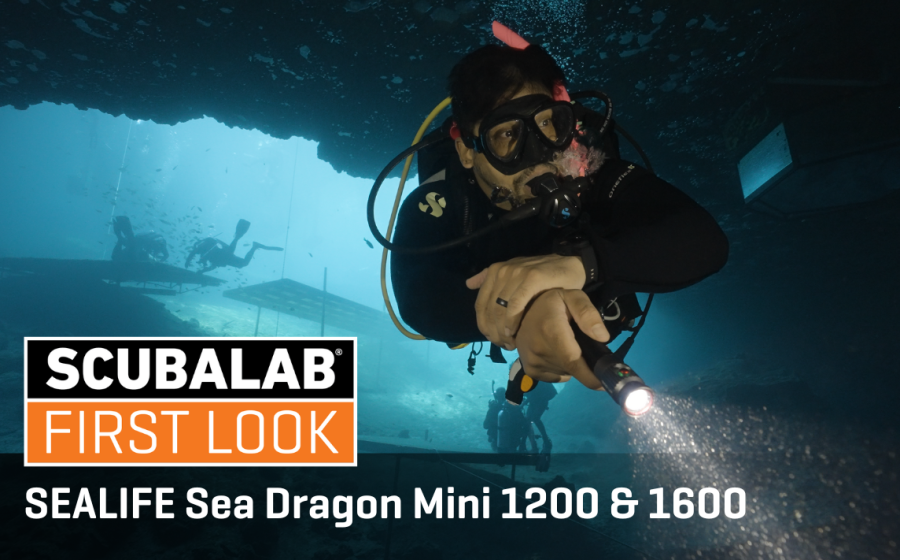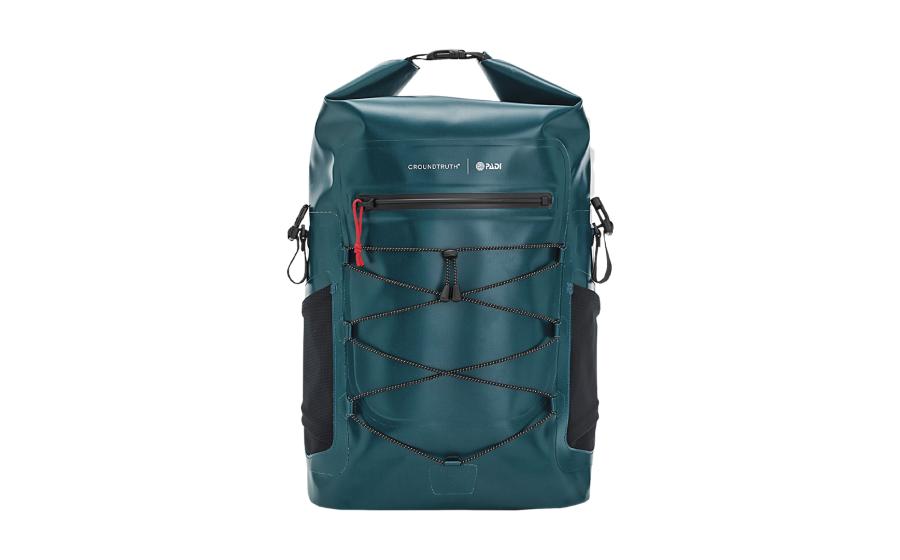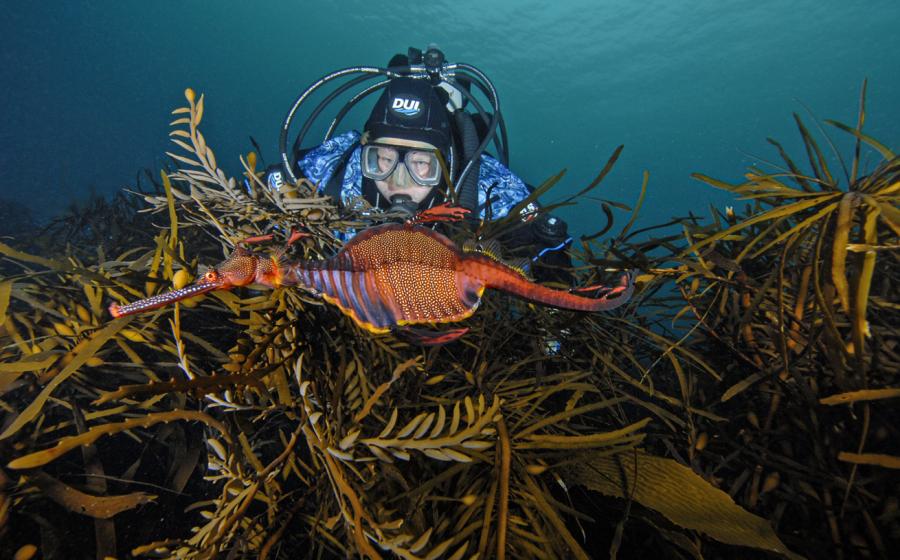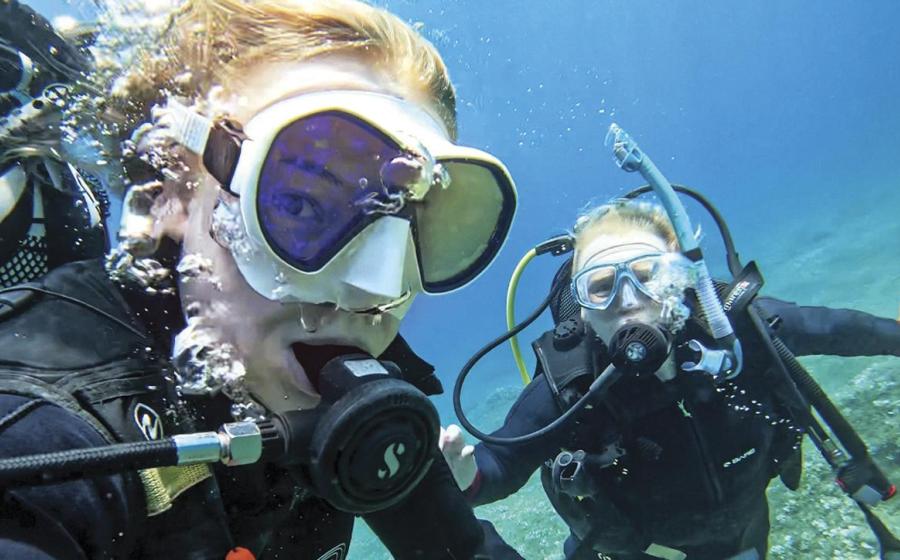Perfecting Point-and-Shoot
Text and Photography by Stephen Frink
||
|---|
|  |
|
| There is a right way and a wrong way to mount a fiber optic. The Sealife DC500 integrates a means to deflect the light from the camera's internal flash down the "pipe" of the fiber optic.|
I just spent a lovely week at Anthony's Key Resort in Roatan, Honduras. Unlike so many of my trips--which tend to be on live-aboards with a group of highly motivated shooters and their expensive housed digital SLR cameras--this week was more casual, and I ended up on a random array of day boats, with different guests on each. Of course, these boats had a camera table that my multi-armed, multi-strobed behemoth would have to share with the other cameras on board. Interestingly, every other still camera I saw during the week was a relatively small digital point-and-shoot in a housing; most were models from Canon, Olympus or Sony in their dedicated housings. Not another digital SLR to be seen. From this relatively small sample, we can't extrapolate the ratio of point-and-shoot cameras to digital SLRs, but it's safe to say there are lots of divers who don't want to spend huge amounts of money to take underwater pictures, who already have a point-and-shoot digital for topside use, and who have discovered that for a few hundred dollars they can get a housing dedicated to their particular camera.
Of course, such an approach may lead to some compromise. Some of the older point-and-shoot cameras in particular suffer from digital lag--the difference between when the shutter release is pressed and the image actually records. That is a huge hassle for critically composed images in a fluid environment, especially one that includes erratically moving fish. But many of the newer cameras have addressed this issue; and it's something a shooter can get used to, like leading a duck before firing the shotgun. Another issue is that the camera's LCD may be hard to view in high ambient light. But this issue is also surmountable because the autofocus on these cameras tends to be so good that all the photographer really has to do is compose and, more often than not, the image will be in focus. Reasonable composition and accurate focus is good enough for many; especially when weighed against the hassle and expense of traveling with a more expensive digital SLR.
Blue and Sloppy
||
|---|
|  |
|
| Merely taping the side of the cord to the housing is an unreliable way to ensure light transmission.|
Yet the ongoing conundrum, and arguably the main reason for dissatisfaction with point-and-shoot underwater photography, is that so often the photos are monochromatic blue or full of backscatter. Both issues are easy to explain:
Lack of color. Water is 600 times denser than air, and it has a color cast as well (cyan in most of the tropical diving world, green in more temperate waters). Most point-and-shoot cameras have a relatively small built-in flash, which is fine for portraits of friends five feet away at a party, but totally inadequate for punching through five feet of ocean water. Actually, the light has to travel 10 feet, because the strobe has to hit the subject and then reflect back to the digital sensor. Should we be surprised the in-camera flash is not up to the task? Working closer to the subject will help for sure, but anything more than about three feet from the strobe will likely be fairly bland. It's a shame, of course, because the underwater world is so brilliantly vibrant when properly lit.
Backscatter. Backscatter is the insidious bits of out-of-focus particles that are illuminated by the strobe. This is not the exclusive province of point-and-shoot cameras, as I have discarded more than my share of backscatter-ridden photos over the years, no matter how clever I tried to be in terms of aiming my strobes. But, the point-and-shoot cameras are especially challenged because the small strobe is so close to the lens. That means that it fully exposes the particles in suspension very near the front port of the housing (and beyond). The strobes on my housing are on long, articulated ball-joint arms so that I can aim them away from those chunks of particulate matter near the housing, and even those that must get illuminated near the subject tend to get rim-lit rather than front-lit, making for a less visible globe of detritus. So, while backscatter may not be eliminated, creative lighting with a strobe well removed from the lens can minimize the problem.
The obvious solution is to add an external strobe to the point-and-shoot housing. An external strobe can be far more powerful than the built-in strobe, and a strobe arm can hold it farther away from the lens to help control backscatter. Then why isn't an external strobe standard equipment with every housing? Two reasons: preflash and connection issues.
The Preflash Problem
||
|---|
|  |
|
| For digital point-and-shoot cameras that offer PC or hot-shoe strobe connections, Ikelite offers the ultimate connection reliability: A strobe hard-wired to a housing bulkhead.|
Many point-and-shoot digital cameras use a preflash that fires just before the actual flash to help the camera determine automatic flash exposure. The external strobe has to emulate the camera's preflash in order to provide the same level of automatic strobe exposure that the camera does, and the strobes that an underwater photographer would typically use either can't read preflash at all, or can't simulate the exact preflash sequence and intensity of the point-and-shoot camera. Therefore, these strobes will have issues with both synchronization and exposure accuracy.
Connection Issues
External strobes fire on signal from the camera one of two ways:
As slaves. A strobe can have an external sensor that reads when the camera's flash goes off, and that burst of light can trigger the slave strobe to fire. With a digital point-and-shoot, this is often problematic because in high ambient light, the shallow water where most of these cameras are used, there might not be enough strobe intensity detected by the slave strobe to cause it to fire. After all, the small strobe in the camera has to overpower the sunlight for the strobe to recognize a difference. And if it does detect the camera's strobe, it still has to read the right burst, that being the primary burst that exposes the sensor, and not the preflash that merely determines the camera strobe's intensity. Finally, unless it is shrouded some way, the camera's flash will still fire into the water column and create backscatter.
A better solution is to hard-wire the strobe. In traditional film cameras, and now replicated in digital SLRs, there is a synch plug (in the old days) or a hot shoe (more common today) that sits atop the viewing prism. A cord slips into that slot within the housing, and connects to a bulkhead fitting on the housing. Then a coiled O-ring-sealed synch cord connects to the external flash so it fires in synch with the camera. Since there is no preflash involved, any of our existing submersible strobes from the analog era will work, and because the Nikonos five-pin connector is still common as a bulkhead fitting, this is a pretty simple "plug-and-play" solution.
But many point-and-shoot cameras don't have hot shoes or synch plugs on the cameras, and most of the housings marketed by the camera companies don't have external bulkhead connectors. If a camera can accept an external flash for topside use, Ikelite typically integrates a bulkhead fitting into its housings. High-end Olympus housings offer a bulkhead fitting, but it is unique to a housing Olympus dedicates to its topside strobe unit. That offers the possibility of digital through-the-lens automation, but the strobe isn't particularly powerful, and because it sits behind a flat port, it has a relatively narrow beam.
||
|---|
|  |
|
| Artful application of strobe light restores the brilliant color of the underwater world to digital pictures taken with point-and-shoot cameras.|
No company offers more external strobe solutions for more digital point-and-shoot cameras than Ikelite. Yet, two more of the biggest players in digital point-and-shoot for underwater use feature their own dedicated camera and housing packages, complete with their own strobe units. A robust fiber-optic cable triggers their strobes, so that when the internal flash goes off in the camera, it travels through a narrow coiled cord and triggers the more powerful external strobe, in synchronization. This ensures that the preflash issues are engineered at the factory level, rather than being reverse-engineered at the consumer end, and makes for beautifully ergonomic packages. The Sealife DC500 and companion digital flash is one example, and the Sea & Sea DX-8000G and YS25 strobe is another.
That still doesn't resolve the monochromatic angst of the thousands of other point-and-shooters out there with their dedicated Canon, Sony and Olympus housings. Fortunately, there are a couple of strobe options for them as well. There are tray/arm/strobe combos by both Sealife and Sea & Sea that allow their fiber-optic systems to attach to most housings, thereby blocking the internal flash and rerouting it through the fiber optic pipe to trigger the external flash. Of course, this assumes that it will read the correct flash and not fire prematurely with the preflash. Sealife handles this by offering an internal five-position switch that allows the strobe to identify the exact preflash sequence emitted by the camera, thereby ensuring synchronization with the main picture-taking flash. To do this, the user simply takes pictures of the strobe head, until he finds the right switch position by trial and error. The switch position used to take a photo that shows the strobe going off is the one that is assuredly in synch. For that camera, the strobe is always left in that particular setting.
OK, so now we have external strobes that can work on most digital point-and-shoot cameras, but do they have automatic through-the-lens metering? Regrettably, probably not. Electronic TTL for digital cameras remains a huge stumbling block that designers are chipping away at, but the big Eureka moment for all cameras and all strobes remains a distant goal. Meanwhile, the best strobes have incremental power settings, and exposure is best done by "shoot and chimp." That is, fire the flash and review the camera's LCD and/or histogram to judge exposure.
Text and Photography by Stephen Frink
|| |---|
| |
| There is a right way and a wrong way to mount a fiber optic. The Sealife DC500 integrates a means to deflect the light from the camera's internal flash down the "pipe" of the fiber optic.|
I just spent a lovely week at Anthony's Key Resort in Roatan, Honduras. Unlike so many of my trips--which tend to be on live-aboards with a group of highly motivated shooters and their expensive housed digital SLR cameras--this week was more casual, and I ended up on a random array of day boats, with different guests on each. Of course, these boats had a camera table that my multi-armed, multi-strobed behemoth would have to share with the other cameras on board. Interestingly, every other still camera I saw during the week was a relatively small digital point-and-shoot in a housing; most were models from Canon, Olympus or Sony in their dedicated housings. Not another digital SLR to be seen. From this relatively small sample, we can't extrapolate the ratio of point-and-shoot cameras to digital SLRs, but it's safe to say there are lots of divers who don't want to spend huge amounts of money to take underwater pictures, who already have a point-and-shoot digital for topside use, and who have discovered that for a few hundred dollars they can get a housing dedicated to their particular camera.
|
| There is a right way and a wrong way to mount a fiber optic. The Sealife DC500 integrates a means to deflect the light from the camera's internal flash down the "pipe" of the fiber optic.|
I just spent a lovely week at Anthony's Key Resort in Roatan, Honduras. Unlike so many of my trips--which tend to be on live-aboards with a group of highly motivated shooters and their expensive housed digital SLR cameras--this week was more casual, and I ended up on a random array of day boats, with different guests on each. Of course, these boats had a camera table that my multi-armed, multi-strobed behemoth would have to share with the other cameras on board. Interestingly, every other still camera I saw during the week was a relatively small digital point-and-shoot in a housing; most were models from Canon, Olympus or Sony in their dedicated housings. Not another digital SLR to be seen. From this relatively small sample, we can't extrapolate the ratio of point-and-shoot cameras to digital SLRs, but it's safe to say there are lots of divers who don't want to spend huge amounts of money to take underwater pictures, who already have a point-and-shoot digital for topside use, and who have discovered that for a few hundred dollars they can get a housing dedicated to their particular camera.
Of course, such an approach may lead to some compromise. Some of the older point-and-shoot cameras in particular suffer from digital lag--the difference between when the shutter release is pressed and the image actually records. That is a huge hassle for critically composed images in a fluid environment, especially one that includes erratically moving fish. But many of the newer cameras have addressed this issue; and it's something a shooter can get used to, like leading a duck before firing the shotgun. Another issue is that the camera's LCD may be hard to view in high ambient light. But this issue is also surmountable because the autofocus on these cameras tends to be so good that all the photographer really has to do is compose and, more often than not, the image will be in focus. Reasonable composition and accurate focus is good enough for many; especially when weighed against the hassle and expense of traveling with a more expensive digital SLR.
Blue and Sloppy
|| |---|
| |
| Merely taping the side of the cord to the housing is an unreliable way to ensure light transmission.|
Yet the ongoing conundrum, and arguably the main reason for dissatisfaction with point-and-shoot underwater photography, is that so often the photos are monochromatic blue or full of backscatter. Both issues are easy to explain:
|
| Merely taping the side of the cord to the housing is an unreliable way to ensure light transmission.|
Yet the ongoing conundrum, and arguably the main reason for dissatisfaction with point-and-shoot underwater photography, is that so often the photos are monochromatic blue or full of backscatter. Both issues are easy to explain:
Lack of color. Water is 600 times denser than air, and it has a color cast as well (cyan in most of the tropical diving world, green in more temperate waters). Most point-and-shoot cameras have a relatively small built-in flash, which is fine for portraits of friends five feet away at a party, but totally inadequate for punching through five feet of ocean water. Actually, the light has to travel 10 feet, because the strobe has to hit the subject and then reflect back to the digital sensor. Should we be surprised the in-camera flash is not up to the task? Working closer to the subject will help for sure, but anything more than about three feet from the strobe will likely be fairly bland. It's a shame, of course, because the underwater world is so brilliantly vibrant when properly lit.
Backscatter. Backscatter is the insidious bits of out-of-focus particles that are illuminated by the strobe. This is not the exclusive province of point-and-shoot cameras, as I have discarded more than my share of backscatter-ridden photos over the years, no matter how clever I tried to be in terms of aiming my strobes. But, the point-and-shoot cameras are especially challenged because the small strobe is so close to the lens. That means that it fully exposes the particles in suspension very near the front port of the housing (and beyond). The strobes on my housing are on long, articulated ball-joint arms so that I can aim them away from those chunks of particulate matter near the housing, and even those that must get illuminated near the subject tend to get rim-lit rather than front-lit, making for a less visible globe of detritus. So, while backscatter may not be eliminated, creative lighting with a strobe well removed from the lens can minimize the problem.
The obvious solution is to add an external strobe to the point-and-shoot housing. An external strobe can be far more powerful than the built-in strobe, and a strobe arm can hold it farther away from the lens to help control backscatter. Then why isn't an external strobe standard equipment with every housing? Two reasons: preflash and connection issues.
The Preflash Problem
|| |---|
| |
| For digital point-and-shoot cameras that offer PC or hot-shoe strobe connections, Ikelite offers the ultimate connection reliability: A strobe hard-wired to a housing bulkhead.|
Many point-and-shoot digital cameras use a preflash that fires just before the actual flash to help the camera determine automatic flash exposure. The external strobe has to emulate the camera's preflash in order to provide the same level of automatic strobe exposure that the camera does, and the strobes that an underwater photographer would typically use either can't read preflash at all, or can't simulate the exact preflash sequence and intensity of the point-and-shoot camera. Therefore, these strobes will have issues with both synchronization and exposure accuracy.
|
| For digital point-and-shoot cameras that offer PC or hot-shoe strobe connections, Ikelite offers the ultimate connection reliability: A strobe hard-wired to a housing bulkhead.|
Many point-and-shoot digital cameras use a preflash that fires just before the actual flash to help the camera determine automatic flash exposure. The external strobe has to emulate the camera's preflash in order to provide the same level of automatic strobe exposure that the camera does, and the strobes that an underwater photographer would typically use either can't read preflash at all, or can't simulate the exact preflash sequence and intensity of the point-and-shoot camera. Therefore, these strobes will have issues with both synchronization and exposure accuracy.
Connection Issues
External strobes fire on signal from the camera one of two ways:
As slaves. A strobe can have an external sensor that reads when the camera's flash goes off, and that burst of light can trigger the slave strobe to fire. With a digital point-and-shoot, this is often problematic because in high ambient light, the shallow water where most of these cameras are used, there might not be enough strobe intensity detected by the slave strobe to cause it to fire. After all, the small strobe in the camera has to overpower the sunlight for the strobe to recognize a difference. And if it does detect the camera's strobe, it still has to read the right burst, that being the primary burst that exposes the sensor, and not the preflash that merely determines the camera strobe's intensity. Finally, unless it is shrouded some way, the camera's flash will still fire into the water column and create backscatter.
A better solution is to hard-wire the strobe. In traditional film cameras, and now replicated in digital SLRs, there is a synch plug (in the old days) or a hot shoe (more common today) that sits atop the viewing prism. A cord slips into that slot within the housing, and connects to a bulkhead fitting on the housing. Then a coiled O-ring-sealed synch cord connects to the external flash so it fires in synch with the camera. Since there is no preflash involved, any of our existing submersible strobes from the analog era will work, and because the Nikonos five-pin connector is still common as a bulkhead fitting, this is a pretty simple "plug-and-play" solution.
But many point-and-shoot cameras don't have hot shoes or synch plugs on the cameras, and most of the housings marketed by the camera companies don't have external bulkhead connectors. If a camera can accept an external flash for topside use, Ikelite typically integrates a bulkhead fitting into its housings. High-end Olympus housings offer a bulkhead fitting, but it is unique to a housing Olympus dedicates to its topside strobe unit. That offers the possibility of digital through-the-lens automation, but the strobe isn't particularly powerful, and because it sits behind a flat port, it has a relatively narrow beam.
|| |---|
| |
| Artful application of strobe light restores the brilliant color of the underwater world to digital pictures taken with point-and-shoot cameras.|
No company offers more external strobe solutions for more digital point-and-shoot cameras than Ikelite. Yet, two more of the biggest players in digital point-and-shoot for underwater use feature their own dedicated camera and housing packages, complete with their own strobe units. A robust fiber-optic cable triggers their strobes, so that when the internal flash goes off in the camera, it travels through a narrow coiled cord and triggers the more powerful external strobe, in synchronization. This ensures that the preflash issues are engineered at the factory level, rather than being reverse-engineered at the consumer end, and makes for beautifully ergonomic packages. The Sealife DC500 and companion digital flash is one example, and the Sea & Sea DX-8000G and YS25 strobe is another.
|
| Artful application of strobe light restores the brilliant color of the underwater world to digital pictures taken with point-and-shoot cameras.|
No company offers more external strobe solutions for more digital point-and-shoot cameras than Ikelite. Yet, two more of the biggest players in digital point-and-shoot for underwater use feature their own dedicated camera and housing packages, complete with their own strobe units. A robust fiber-optic cable triggers their strobes, so that when the internal flash goes off in the camera, it travels through a narrow coiled cord and triggers the more powerful external strobe, in synchronization. This ensures that the preflash issues are engineered at the factory level, rather than being reverse-engineered at the consumer end, and makes for beautifully ergonomic packages. The Sealife DC500 and companion digital flash is one example, and the Sea & Sea DX-8000G and YS25 strobe is another.
That still doesn't resolve the monochromatic angst of the thousands of other point-and-shooters out there with their dedicated Canon, Sony and Olympus housings. Fortunately, there are a couple of strobe options for them as well. There are tray/arm/strobe combos by both Sealife and Sea & Sea that allow their fiber-optic systems to attach to most housings, thereby blocking the internal flash and rerouting it through the fiber optic pipe to trigger the external flash. Of course, this assumes that it will read the correct flash and not fire prematurely with the preflash. Sealife handles this by offering an internal five-position switch that allows the strobe to identify the exact preflash sequence emitted by the camera, thereby ensuring synchronization with the main picture-taking flash. To do this, the user simply takes pictures of the strobe head, until he finds the right switch position by trial and error. The switch position used to take a photo that shows the strobe going off is the one that is assuredly in synch. For that camera, the strobe is always left in that particular setting.
OK, so now we have external strobes that can work on most digital point-and-shoot cameras, but do they have automatic through-the-lens metering? Regrettably, probably not. Electronic TTL for digital cameras remains a huge stumbling block that designers are chipping away at, but the big Eureka moment for all cameras and all strobes remains a distant goal. Meanwhile, the best strobes have incremental power settings, and exposure is best done by "shoot and chimp." That is, fire the flash and review the camera's LCD and/or histogram to judge exposure.






